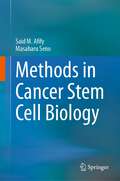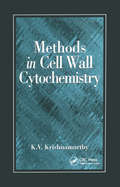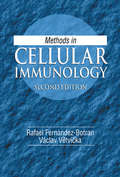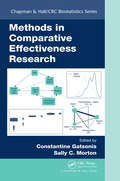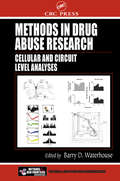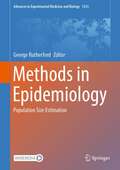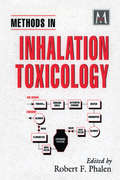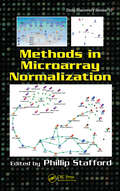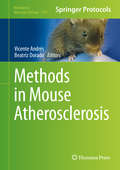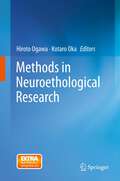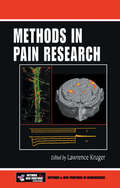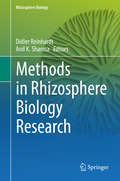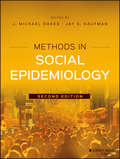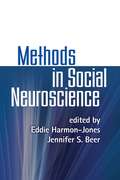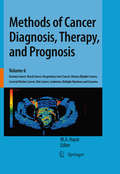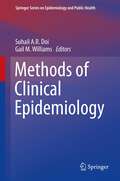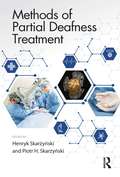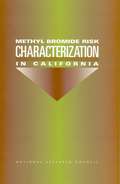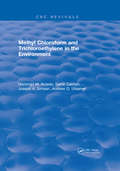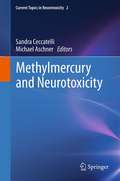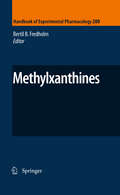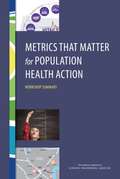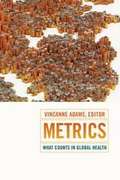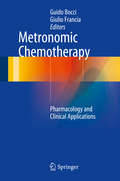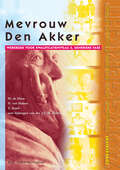- Table View
- List View
Methods in Cancer Stem Cell Biology
by Said M. Afify Masaharu SenoThis book describes the use of stem cells and cancer stem cell generation in the inflammatory microenvironment (cancer-inducing niche) using induced pluripotent stem cells. It provides step-by-step techniques and manuals for studying stem cell and cancer stem cell generation with different applications in cancer research. The development of induced pluripotent stem cells has provided a new approach to studying cancer initiation by producing cancer stem cells without introducing mutations or foreign genes. The book features the research of the authors’ group, which was the first to generate cancer stem cells from stem cells in the presence of inflammatory conditions. The 20 chapters of this book cover topics such as generating pluripotent stem cells, converting normal stem cells to cancer stem cells, enriching, isolating and evaluating cancer stem cells. Methods for evaluating the characteristics of cancer stem cells and possible therapies against them are also discussed. The book provides easy-to-follow protocols that help researchers in the study of cancer stem cells. Illustrations help readers understand how the method of cancer stem cell generation can be applied as an essential method for assessing the carcinogenic potential of various non-mutagenic compounds. It will be a useful resource for graduate students, researchers, technicians, and physicians working in academic, hospital, and pharmaceutical settings.
Methods in Cell Wall Cytochemistry
by K V KrishnamurthyVarious methodologies designed to study cell walls are compiled in this book. Methods in Cell Wall Cytochemistry covers the use of modern dyes, fluorescent chemicals, lectins, and antibody technology (immunocytochemisty.)Cell wall morphology and chemical composition is covered as well as light and fluorescent cytochemistry; transmission electron microscopic cytochemistry; lectin cytochemistry; and, special emphasis on immunocytochemistry. Addressing an emerging area of research and technology, this book will appeal to plant pathologists, cell biologists, as well as workers interested in stress response and those employing cell walls for biotechnological research.
Methods in Cellular Immunology
by Rafael Fernandez-Botran Vaclav VetvickaA step-by-step guide to commonly used procedures, Methods in Cellular Immunology addresses both human and murine models, in addition to such topics as PCR and apoptosis. The basic format of the original version has been maintained, and the goal remains the same: to make it a useful and easy-to-use tool for investigators employing cellular immunolog
Methods in Comparative Effectiveness Research (Chapman & Hall/CRC Biostatistics Series)
by Sally C. Morton Constantine GatsonisComparative effectiveness research (CER) is the generation and synthesis of evidence that compares the benefits and harms of alternative methods to prevent, diagnose, treat, and monitor a clinical condition or to improve the delivery of care (IOM 2009). CER is conducted to develop evidence that will aid patients, clinicians, purchasers, and health policy makers in making informed decisions at both the individual and population levels. CER encompasses a very broad range of types of studies—experimental, observational, prospective, retrospective, and research synthesis. This volume covers the main areas of quantitative methodology for the design and analysis of CER studies. The volume has four major sections—causal inference; clinical trials; research synthesis; and specialized topics. The audience includes CER methodologists, quantitative-trained researchers interested in CER, and graduate students in statistics, epidemiology, and health services and outcomes research. The book assumes a masters-level course in regression analysis and familiarity with clinical research.
Methods in Drug Abuse Research: Cellular and Circuit Level Analyses (Frontiers in Neuroscience)
by Barry D. WaterhouseThe field of drug addiction and substance abuse, which was initially confined to behavioral studies, has broadened dramatically. It now includes a vast array of cellular and molecular approaches as well as sophisticated electrophysiological and neurochemical methodologies that bridge the gap between cellular/molecular events and behavior. In many c
Methods in Epidemiology: Population Size Estimation (Advances in Experimental Medicine and Biology #1333)
by George RutherfordThis book describes the variety of direct and indirect population size estimation (PSE) methods available along with their strengths and weaknesses. Direct estimation methods, such as enumeration and mapping, involve contact with members of hard-to-reach groups. Indirect methods have practical appeal because they require no contact with members of hard-to-reach groups. One indirect method in particular, network scale-up (NSU), has several strengths over other PSE methods: It can be applied at a province/country level, it can estimate size of several hard-to-reach population in a single study, and it is implemented with members of the general population rather than members of hard-to-reach groups.The book discusses methods to collect, analyze, and adjust results and presents methods to triangulate and finalize PSEs.
Methods in Inhalation Toxicology (Methods In Life Sciences - Toxicology Section Ser. #3)
by Robert F. PhalenThis book focuses on an important aspect of the methods in laboratory animal inhalation toxicology. It is targeted to students in toxicology programs and scientists contemplating performing inhalation studies.
Methods in Microarray Normalization (Drug Discovery Series)
by Phillip StaffordThis organized text compiles, for the first time, the most useful normalization methods developed for interpreting microarray data. Experts examine the mathematical processes that are important in normalizing data and avoiding inherent systematic biases. They also review modern software, including discussions on key algorithms, comparative data, and download locations. The book contains the latest microarray innovations from companies such as Agilent, Affymetrix, and GeneGo as well as new, readily adaptable normalization methods for expression and CGH arrays. It also lists of open-source molecular profiling normalization algorithms available and where to access them.
Methods in Mouse Atherosclerosis
by Vicente Andrés Beatriz DoradoThis volume reviews available mouse models of atherosclerosis, basic aspects of disease initiation and progression, and the visualization of atherosclerotic lesions with invasive and non-invasive techniques that are widely used both in basic research and in the clinic. The chapters catalogue a wide range of in vitro and in vivo experimental methods used for atherosclerosis research, including thorough protocols and valuable notes based on the authors' personal wet lab experience. Written in the highly successful Methods in Molecular Biology series format, chapters include introductions to their respective topics, lists of the necessary materials and reagents, step-by-step, readily reproducible laboratory protocols, and key tips on troubleshooting and avoiding known pitfalls. Authoritative and practical, Methods in Mouse Atherosclerosis will be a valuable working guide for researchers performing mouse-based atherosclerosis studies.
Methods in Neuroethological Research
by Hiroto Ogawa Kotaro OkaThe rapid progress of neuroscience in the last decade can be largely attributed to significant advances in neuroethology, a branch of science that seeks to understand the neural basis of natural animal behavior. Novel approaches including molecular biological techniques, optical recording methods, functional anatomy, and informatics have brought drastic changes in how the neural systems underlying high-level behaviors such as learning and memory are described. This book introduces recent research techniques in neuroethology, with diverse topics involving nematodes, insects, and vertebrates (birds, mice and primates), divided into sections by research method. Each section consists of two chapters written by different authors who have developed their own unique approaches. Reports of research in "model animals" including C. elegans, Drosophila, and mice, which were not typical specimens in conventional neuroethology, have been deliberately selected for this book because a molecular genetic approach to these animals is necessary for advances in neuroethology. Novel methodology including optical recording and functional labeling with reporter genes such as GFP has been actively used in recent neurobiological studies, and genetic manipulation techniques such as optogenetics also are powerful tools for understanding the molecular basis of neural systems for animal behavior. This book provides not only these new strategies but also thought-provoking statements of philosophy in neuroethology for students and young researchers in the biological sciences.
Methods in Pain Research
by Lawrence KrugerIn the past two decades, pain research has become one of the most rapidly growing areas of neuroscience activity. Methods in Pain Research brings together in a single volume a survey of the methods that can be used to study a reaction or 'sensory report' in humans that can only be inferred by indirect means in animal or tissues studies. It presents
Methods in Rhizosphere Biology Research (Rhizosphere Biology)
by Anil K. Sharma Didier ReinhardtThis book compiles various methodologies used in understanding interactions within the rhizosphere. An in-depth understanding of the rhizosphere is essential to developing successful strategies for future sustainable agriculture. The book summarizes methods and techniques used to study the mechanisms involved in mutualistic symbioses and pathogenic interactions of plants with various microbial organisms including fungi, bacteria, and oomycetes. Each chapter discusses different methodologies used in rhizosphere biology, while also providing real-world experimental data and trouble-shooting tips. Interested researchers will also find a wealth of literature references for further research. As the first comprehensive manual and compilation of methods and techniques used in rhizosphere biology, the book represents an essential resource for all researchers who are newcomers to soil microbiology experimentation.
Methods in Social Epidemiology
by J. Michael Oakes Jay S. KaufmanA thorough, practical reference on the social patterns behind health outcomes Methods in Social Epidemiology provides students and professionals with a comprehensive reference for studying the social distribution and social determinants of health. Covering the theory, models, and methods used to measure and analyze these phenomena, this book serves as both an introduction to the field and a practical manual for data collection and analysis. This new second edition has been updated to reflect the field's tremendous growth in recent years, including advancements in statistical modeling and study designs. New chapters delve into genetic methods, structural cofounding, selection bias, network methods, and more, including new discussion on qualitative data collection with disadvantaged populations. Social epidemiology studies the way society's innumerable social interactions, both past and present, yields different exposures and health outcomes between individuals within populations. This book provides a thorough, detailed overview of the field, with expert guidance toward the real-world methods that fuel the latest advances. Identify, measure, and track health patterns in the population Discover how poverty, race, and socioeconomic factors become risk factors for disease Learn qualitative data collection techniques and methods of statistical analysis Examine up-to-date models, theory, and frameworks in the social epidemiology sphere As the field continues to evolve, researchers continue to identify new disease-specific risk factors and learn more about how the social system promotes and maintains well-known exposure disparities. New technology in data science and genomics allows for more rigorous investigation and analysis, while the general thinking in the field has become more targeted and attentive to causal inference and core assumptions behind effect identification. It's an exciting time to be a part of the field, and Methods in Social Epidemiology provides a solid reference for any student, researcher, or faculty in public health.
Methods in Social Neuroscience
by Jennifer S. Beer Eddie Harmon-JonesStraightforward and practical, this is the first book to provide detailed guidance for using neurobiological methods in the study of human social behavior, personality, and affect. Each chapter clearly introduces the method at hand, provides examples of the method's applications, discusses its strengths and limitations, and reviews concrete experimental design considerations. Written by acknowledged experts, chapters cover neuroimaging techniques, genetic measurement, hormonal methods, lesion studies, startle eyeblink responses, facial electromyography, autonomic nervous system responses, and modeling based on neural networks.
Methods of Cancer Diagnosis, Therapy, and Prognosis
by M. A. HayatThe seventh volume of the series, Methods of Cancer Diagnosis, Therapy, and Prognosis, discusses General Methods, Overviews, Head and Neck Cancer, and Thyroid Cancer. As in the other six volumes of the series, these subjects are discussed in detail. This fully illustrated volume presents overviews in Radio-immunotherapy in Cancer, Multidrug Resistance, Cancer Biomarkers, Role of Antibodies in Cancer Treatment, Classification of Cancer Stage Using Patient's Immune System, Cancer Stem Cells, General methods discussed are, Translating In Vitro Cell Lines Result into Clinical Practice, Late Relapse of Germ Cell Malignancies, Role of RNA Interference in Understanding the Molecular Bases of Cancer, Incorporating Pharmacogenomics into Cancer Therapy, Tumor Angiogenesis in Cancer, Spindle Cell Oncocytoma of the Adenohypophysis, Chemotherapy-Induced Neurotoxicity, Disseminated Carcinoma of Unknown Primary Site, Unknown Lymphadenopathy. In part 2 of this volume Head and Neck Squamous Cell Carcinoma, Early Stage Oral Squamous Cell Carcinoma, Salivary Gland Tumors, Retinoblastoma, Tongue Cancer Metastasis, Role of Human Papilloma Virus in Tonsillar Cancer and Nasopharyngeal Carcinoma are discussed. Part 3 discusses in detail Thyroid Carcinoma, including Papillary Thyroid Carcinoma, Molecular Genetics of the Thyroid, Medullary Thyroid Carcinoma, PET Imaging in Thyroid carcinoma, Thyroid Cancer and Markers for Diagnosis, Metastasized Medullary Thyroid Carcinoma, and Prognostic Factors in Thyroid Carcinoma. The information presented in this volume should help in the development of novel, more effective therapeutic approaches for the treatment of head and neck cancer and thyroid cancer. Professor Hayat has summarized the problems associated with the complexities of research publications and has been successful in editing a must-read volume for oncologists, cancer researchers, medical teachers and students of cancer biology.
Methods of Clinical Epidemiology
by Gail M. Williams Suhail A. Doi"Methods of Clinical Epidemiology" serves as a text on methods useful to clinical researchers. It provides a clear introduction to the common research methodology specific to clinical research for both students and researchers. This book sets out to fill the gap left by texts that concentrate on public health epidemiology and focuses on what is not covered well in such texts. The four sections cover methods that have not previously been brought together in one text and serves as a second level textbook of clinical epidemiology methodology. This book will be of use to postgraduate students in clinical epidemiology as well as clinical researchers at the start of their careers.
Methods of Partial Deafness Treatment
by Henryk SkarżyńskiThis book presents the revolutionary approach to the treatment of hearing loss proposed by Professor Henryk Skarżyński and developed in collaboration with the group of internationally recognized experts on clinical and experimental otolaryngology, otosurgery, and audiology. The authors present an in-depth look at different aspects of this comprehensive concept of treatment of partial and total deafness with hearing implants, and discuss the approaches to diagnostics and patient selection, results in different groups of patients, the surgical technique, and procedures. This book also covers audiological aspects, auditory training, patient's performance, and psychology. This book is a comprehensive review of the method of partial and total deafness treatment developed and introduced into clinical practice by Professor Henryk Skarżyński. The publication is noteworthy for presenting a multifaceted approach to the subject from related science experts’ and clinicians’ point of view.
Methyl Bromide Risk Characterization In California
by National Research CouncilThe National Academies Press (NAP)--publisher for the National Academies--publishes more than 200 books a year offering the most authoritative views, definitive information, and groundbreaking recommendations on a wide range of topics in science, engineering, and health. Our books are unique in that they are authored by the nation's leading experts in every scientific field.
Methyl Chloroform and Trichloroethylene in the Environment
by D. M. AviadoIn the present and subsequent volumes of this book, critical coverage of the literature will be combined with the fruits of original and highly relevant research carried out by Dr. D.M Aviado and his colleagues. The total effort constitutes an authoritative up-to-date appraisal of the knowledge needed to understand the inhalational toxicity and other biological effects of an important and ubiquitous class of chemical agents.
Methylmercury and Neurotoxicity
by Sandra Ceccatelli Michael AschnerMercury (Hg) is a global pollutant that knows no environmental boundaries. Even the most stringent control of anthropogenic Hg sources will not eliminate exposure given its ubiquitous presence. Exposure to Hg occurs primarily via the food chain due to MeHg's accumulation in fish. Latest US statistics indicate that 46 States have fish consumption advisories. In addition, Hg is a common pollutant in hazardous waste sites, with an estimated 3-4 million children living within one mile of at least one of the 1,300+ active hazardous waste sites in the US. The effects on intellectual function in children prenatally exposed to MeHg via maternal fish consumption have been the subject of two on-going major, prospective, longitudinal studies in the Seychelles and the Faroe Islands. It is important to recognize that the risk for MeHg exposure is not limited only to islanders with high fish consumption. This book will provide state-of-the-art information to the graduate student training in toxicology, risk assessors, researchers and medical providers at large. It is aimed to bring the reader up to date on contemporary issues associated with exposure to methylmercury, from its effects on stem cells and neurons to population studies.
Methylxanthines
by Bertil B. FredholmIn the present volume of the Handbook of Experimental Pharmacology well known experts describe the actions of different xanthines with a focus on caffeine and theophylline. A special chapter is devoted to theobromine, an active component of chocolate, the actions of which are less well characterized. This book also presents the pharmacology of one xanthine derivative, propentofylline, as an example of a xanthine that has gone through extensive development for a novel therapeutic area.
Metrics That Matter for Population Health Action: Workshop Summary
by Engineering Medicine National Academies of SciencesIn times of rapid change and constrained resources, measures that are important, focused, and reliable are vital. However there is an overabundance of measures available for evaluating various aspects of population health and previous efforts to simplify existing sets to meet the needs of all decision makers have been unsuccessful. The National Academies of Sciences, Engineering, and Medicine convened a workshop to explore the status and uses of measures and measurement in the work of improving population health. Participants explored existing and emerging population health metric sets and characteristics of metrics necessary for stakeholder action across multiple sectors. This report summarizes the presentations and discussions from the workshop.
Metrics: What Counts in Global Health
by Vincanne AdamsThis volume's contributors evaluate the accomplishments, limits, and consequences of using quantitative metrics in global health. Whether analyzing maternal mortality rates, the relationships between political goals and metrics data, or the links between health outcomes and a program's fiscal support, the contributors question the ability of metrics to solve global health problems. They capture a moment when global health scholars and practitioners must evaluate the potential effectiveness and pitfalls of different metrics--even as they remain elusive and problematic. Contributors. Vincanne Adams, Susan Erikson, Molly Hales, Pierre Minn, Adeola Oni-Orisan, Carolyn Smith-Morris, Marlee Tichenor, Lily Walkover, Claire L. Wendland
Metronomic Chemotherapy
by Guido Bocci Giulio FranciaThis book analyzes all aspects of metronomic chemotherapy, a new approach involving low-dose, long-term, and frequently administered therapy that has preclinical and clinical activity in various tumors. After an opening section on the pharmacological bases of metronomic chemotherapy, including its antiangiogenic effects and impact on immunity, preclinical studies on various classes of drug are discussed. Clinical applications of metronomic chemotherapy in a wide variety of tumors are then addressed in detail, with description of the results of all published studies. The clinical pharmacology of metronomic chemotherapy is also considered in depth, encompassing pharmacokinetics, pharmacogenetics, pharmacoeconomics, and adverse drug reactions. The book closes by describing the role of this therapy in the veterinarian clinic.
Mevrouw Den Akker
by Y. Smid M. De Haan N. Van HalemHoofdpersoon in de casus is mevrouw Den Akker. Een oudere dame, die na een leven met haar echtgenoot, haar werk, de zorg voor de kinderen en allerlei activiteiten in de samenleving, nu in allerlei opzichten achteruit gaat en verzorgd moet worden. Een dame die je in menig verzorgingshuis zou kunnen tegenkomen. De specifieke zorg voor mevrouw Den Akker op het gebied van voeding en uitscheiding heeft in deze casus met het clusterthema "voeding en uitscheiding" speciaal de aandacht.
